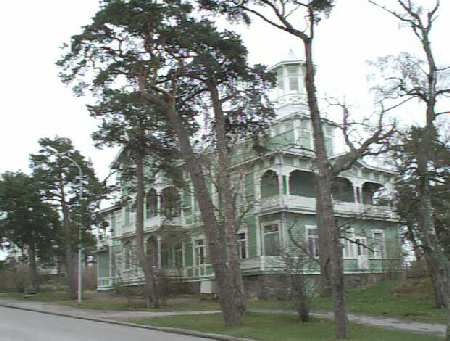
The Soviet Army in Hanko
The Continuation War having proceeded to the stage when the Germans occupied Estonia, the enemy was in a plight in their Hanko base. The maintenance connections overland had already been cut at the outbreak of the war and the loss of Estonia hampered the sea connection with Lenigrad. The Finnish troops occupied Hanko on December 4, 1941. At this stage the Soviet base had already been evacuated by sea in early December. During the evacuation (on the Josef Stalin vessel, for example) the Soviet troops suffered considerable losses on the sea.
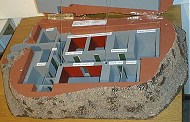 HAll the 8,000 residents of Hanko had been evacuated, and the Soviet army settled down in their new base. According to the map the borderline ran in the area of Lappohja. The Finns began the fortification whose traces can still be seen in several places in the former border area. General Kabanov was built a stately command dugout near the Casino in the park area.
HAll the 8,000 residents of Hanko had been evacuated, and the Soviet army settled down in their new base. According to the map the borderline ran in the area of Lappohja. The Finns began the fortification whose traces can still be seen in several places in the former border area. General Kabanov was built a stately command dugout near the Casino in the park area.
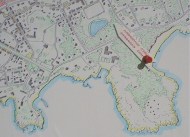 In addition to the command dugout, other underground premises had also been built in the area. To protect Kabanov's dugout from gunfire, the entrance had been lined with gravestones taken from the Hanko cemetery. All these dugouts have been destroyed after the war.
In addition to the command dugout, other underground premises had also been built in the area. To protect Kabanov's dugout from gunfire, the entrance had been lined with gravestones taken from the Hanko cemetery. All these dugouts have been destroyed after the war.
.
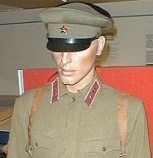 The base was fairly strong and was supported not only by land and sea forces but also by air forces that operated from the airfield built in Täktom. There were also large railway guns in Täktom with the firing range of even 50 kilometres.
The base was fairly strong and was supported not only by land and sea forces but also by air forces that operated from the airfield built in Täktom. There were also large railway guns in Täktom with the firing range of even 50 kilometres.
The bulk of the Russians who were killed on the base have been buried alongside the road from Hanko to Täktom. A monument has later been erected on the place. After the outbreak of the Continuation War the Finns made efforts to isolate the enemy base, and the German advance to Estonia made the situation unbearable for the enemy.
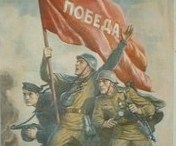 General Kabanov effectuated a skillful withdrawal from the base and brought most of the garrison safely to Leningrad. A number of the evacuation vessels were, however, destroyed on the way. The Josef Stalin, a large passenger ship, ran into a mine and several thousands of passengers were drowned or taken prisoner. All in all, approximately 5,000 men of the total of 28,000 were killed or taken prisoner. A Hanko Museum was established in Leningrad to commemorate the events. This museum has now been closed, but there is an exhibition in the school number 358 of Kupitshno in present St Petersburg. The articles have been transported to the museum of Leningrad siege. Before the Continuation War the garrison led a rather normal life and was able to enjoy the summer of 1940 in Hanko.
General Kabanov effectuated a skillful withdrawal from the base and brought most of the garrison safely to Leningrad. A number of the evacuation vessels were, however, destroyed on the way. The Josef Stalin, a large passenger ship, ran into a mine and several thousands of passengers were drowned or taken prisoner. All in all, approximately 5,000 men of the total of 28,000 were killed or taken prisoner. A Hanko Museum was established in Leningrad to commemorate the events. This museum has now been closed, but there is an exhibition in the school number 358 of Kupitshno in present St Petersburg. The articles have been transported to the museum of Leningrad siege. Before the Continuation War the garrison led a rather normal life and was able to enjoy the summer of 1940 in Hanko.
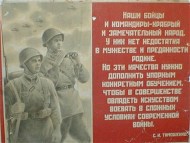 After the Continuation War, General Kabanov returned to the post of the commander of the Porkkala base. His former achievements in Hanko had evidently been greatly appreciated.
After the Continuation War, General Kabanov returned to the post of the commander of the Porkkala base. His former achievements in Hanko had evidently been greatly appreciated.
After the Continuation War, there were no further demands for the Hanko base. The Gulf of Finland is at its narrowest between Porkkala and the island of Naissaari!
Residences | Louhisaari | Marshal's Cabin | Boman Villa | Kirkniemi | Val-Mont | Stamps | Cars | Riding | Journeys | Hunting | Weapons | Outfits | Memoirs | Files | Mannerheim Literature | Monuments | Statue | Dishes | Jäger Flag | Hanko | Mannerheim-museo | Karjalaan jääneet sankarivainajat | Videot ja kuvakirjastot | Linkkisivu
COURSE OF LIFE | FAMILY | TIME OF GROWTH | MILITARY CAREER | WAR OF INDEPENDENCE | REGENT 1918-1919 | CIVILIAN | DEFENCE COUNCIL | COMMANDER-IN-CHIEF 1939-1946 | PRESIDENT OF THE REPUBLIC 1944-1946 | RETIREMENT | SPECIAL TOPICS | SEARCH
